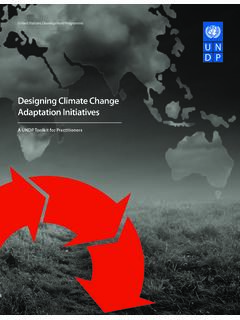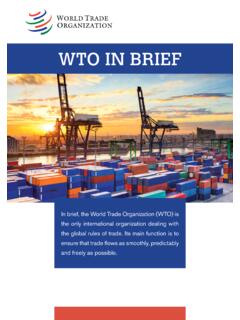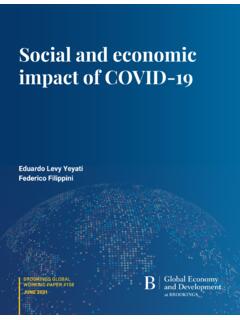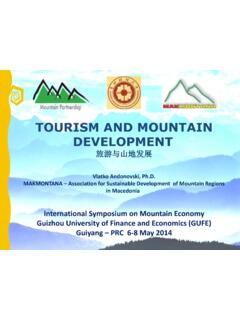Transcription of Population Dynamics - Un
1 Population Dynamics Thematic Think Piece UNDESA, UNFPA The views expressed in this paper are those of the signing agencies and do not necessarily reflect the views of the United Nations. May 2012 2 Following on the outcome of the 2010 High-level Plenary Meeting of the General Assembly on the Millennium Development Goals, the United Nations Secretary-General established the UN System Task Team in September 2011 to support UN system-wide preparations for the post-2015 UN development agenda, in consultation with all stakeholders.
2 The Task Team is led by the Department of Economic and Social Affairs and the United Nations Development Programme and brings together senior experts from over 50 UN entities and international organizations to provide system-wide support to the post-2015 consultation process, including analytical input, expertise and outreach. 3 Population Dynamics 1. Relevance The global Population has increased by two billion over the last 25 years, surpassing the 7 billion mark in late 2011. It is likely to increase by at least another two billion by 2050. Beyond the sheer numbers, the world is faced with unprecedented diversity in demographic situations across countries and regions, as well as within countries.
3 Such diversity is mostly found in evolving demographic structures and the changing proportions of youth and elderly groups, and in different rates of fertility, morbidity and mortality, Population growth, urbanization, and internal and international migration. In addition, there are persistent inequalities of income and opportunity within and across countries and regions. Such inequalities are often associated with aspects such as age, gender, ethnicity and race. National averages, which may show improvements at the country level, often hide severe sub-national disparities in economic opportunities and access to basic social and health services, including reproductive health services.
4 Population Dynamics , particularly in the context of persistent inequalities, will have major influence on development processes and on the inclusive and balanced growth and outcomes in the coming decades. They also challenge the capacity of countries to achieve broad-based development goals. 2. Why should Population issues be part of the post-2015 development agenda Population Dynamics -- including changes in Population growth rates, age structures and distributions of people -- are closely linked to national and global developmental challenges and their solutions.
5 Indeed, none of the greatest challenges of our time can be resolved without attention to Population Dynamics . Much of the projected growth in Population in coming decades will take place in developing and the least developed countries, where it is likely to exacerbate poverty and add pressure on the economy, basic health and social 4 services and the environment. Though mortality has been declining and people are living longer in all countries of the world, many developing countries continue to have high fertility, unacceptably high rates of morbidity and mortality and low life expectancy that hinder development.
6 In the developed and middle-income countries with low fertility, Population numbers are likely to remain stable or even decline. These countries will experience shrinking working-age populations and rapid Population ageing. Demographic changes in the past decades have led to the largest generation of youth in the world today. Globally there were billion young people aged 15 24 in 2010. High-fertility countries in sub-Saharan Africa are projected to experience a rapid increase in the Population aged 15 24, from 173 million at present to 362 million by mid-century.
7 Conversely, the youth Population in the more developed countries has been declining in both absolute numbers and in proportion to older adults, with implications for labour supply and old-age support ratios. Young people are the custodians of the future and can be at the forefront of technological innovation and social transformation if provided with quality education and decent job opportunities. Ageing is another major outcome of demographic change resulting from fertility decline and increased longevity. The number and proportion of older persons aged 60 years or over are rising in all countries.
8 Globally, the number of older persons aged 60 years or over is projected to increase from 810 million now to more than 2 billion in 2050. Older persons are the world s fastest growing Population group, amid rapidly changing family structures and declining family support systems. This global trend of ageing populations has major implications for social security, health care systems, protecting older people s rights and interests and associated development strategies. More than half of the world Population already lives in urban areas and, as development continues, urbanization is certain to increase.
9 Nearly all of the world s Population growth in the coming decades is projected to occur in the cities and towns of developing countries. Urbanization, if well planned, has the potential to improve people s access to education, health, housing, and other services and to expand their opportunities for economic productivity. However, urban Population growth also presents challenges for urban 5 planning and good governance, particularly when that growth is rapid and countries and localities are not prepared for it. Migration flows and patterns are primarily driven by economic disparities, facilitated by low-cost transportation, improved communication and migrant networks.
10 Migration can also be driven by political instability or conflict, natural or man-made disasters, including environmental degradation or chemical or nuclear disasters and famine or even development projects. The global stock of international migrants increased from 156 million in 1990 to 214 million in 2010, and this rising trend is likely to continue in the foreseeable future. Migration policies and international cooperation play an important role in determining the flows and the conditions of integration of migrants in destination countries, as well as their contributions to the countries of origin.

















